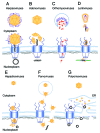Virus strategies for passing the nuclear envelope barrier
- PMID: 22929056
- PMCID: PMC3515536
- DOI: 10.4161/nucl.21979
Virus strategies for passing the nuclear envelope barrier
Abstract
Viruses that replicate in the nucleus need to pass the nuclear envelope barrier during infection. Research in recent years indicates that the nuclear envelope is a major hurdle for many viruses. This review describes strategies to overcome this obstacle developed by seven virus families: herpesviridae, adenoviridae, orthomyxoviridae, lentiviruses (which are part of retroviridae), Hepadnaviridae, parvoviridae and polyomaviridae. Most viruses use the canonical nuclear pore complex (NPC) in order to get their genome into the nucleus. Viral capsids that are larger than the nuclear pore disassemble before or during passing through the NPC, thus allowing genome nuclear entry. Surprisingly, increasing evidence suggest that parvoviruses and polyomaviruses may bypass the nuclear pore by trafficking directly through the nuclear membrane. Additional studies are required for better understanding these processes. Since nuclear entry emerges as the limiting step in infection for many viruses, it may serve as an ideal target for antiviral drug development.
Figures

Similar articles
-
How viruses access the nucleus.Biochim Biophys Acta. 2011 Sep;1813(9):1634-45. doi: 10.1016/j.bbamcr.2010.12.009. Epub 2010 Dec 15. Biochim Biophys Acta. 2011. PMID: 21167871 Review.
-
Old foes, new understandings: nuclear entry of small non-enveloped DNA viruses.Curr Opin Virol. 2015 Jun;12:59-65. doi: 10.1016/j.coviro.2015.03.017. Epub 2015 Apr 4. Curr Opin Virol. 2015. PMID: 25846849 Review.
-
Effect of viral infection on the nuclear envelope and nuclear pore complex.Int Rev Cell Mol Biol. 2012;299:117-59. doi: 10.1016/B978-0-12-394310-1.00003-5. Int Rev Cell Mol Biol. 2012. PMID: 22959302 Review.
-
Breaching the Barrier-The Nuclear Envelope in Virus Infection.J Mol Biol. 2016 May 22;428(10 Pt A):1949-61. doi: 10.1016/j.jmb.2015.10.001. Epub 2015 Oct 29. J Mol Biol. 2016. PMID: 26522933 Review.
-
Protoparvovirus Knocking at the Nuclear Door.Viruses. 2017 Oct 2;9(10):286. doi: 10.3390/v9100286. Viruses. 2017. PMID: 28974036 Free PMC article. Review.
Cited by
-
Strategies for Targeting Retroviral Integration for Safer Gene Therapy: Advances and Challenges.Front Mol Biosci. 2021 May 12;8:662331. doi: 10.3389/fmolb.2021.662331. eCollection 2021. Front Mol Biosci. 2021. PMID: 34055882 Free PMC article. Review.
-
Relationships between A(H1N1)pdm09 influenza infection and infections with other respiratory viruses.Influenza Other Respir Viruses. 2014 Jul;8(4):422-30. doi: 10.1111/irv.12249. Epub 2014 Apr 4. Influenza Other Respir Viruses. 2014. PMID: 24698156 Free PMC article.
-
Imaging, Tracking and Computational Analyses of Virus Entry and Egress with the Cytoskeleton.Viruses. 2018 Mar 31;10(4):166. doi: 10.3390/v10040166. Viruses. 2018. PMID: 29614729 Free PMC article. Review.
-
Histone Deacetylase Inhibitors Reduce the Number of Herpes Simplex Virus-1 Genomes Initiating Expression in Individual Cells.Front Microbiol. 2016 Dec 6;7:1970. doi: 10.3389/fmicb.2016.01970. eCollection 2016. Front Microbiol. 2016. PMID: 27999572 Free PMC article.
-
A viral ubiquitination switch attenuates innate immunity and triggers nuclear import of virion DNA and infection.Sci Adv. 2021 Dec 17;7(51):eabl7150. doi: 10.1126/sciadv.abl7150. Epub 2021 Dec 17. Sci Adv. 2021. PMID: 34919430 Free PMC article.
References
-
- Lin F, Worman HJ. Structural organization of the human gene encoding nuclear lamin A and nuclear lamin C. J Biol Chem. 1993;268:16321–6. - PubMed
Publication types
MeSH terms
Substances
LinkOut - more resources
Full Text Sources
